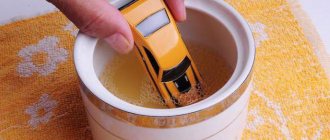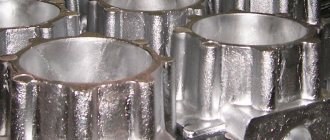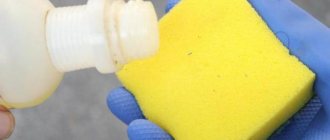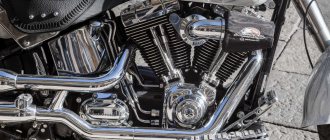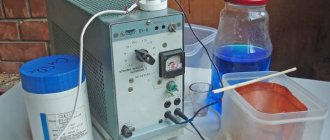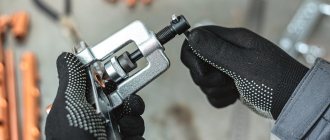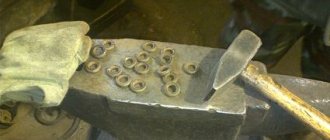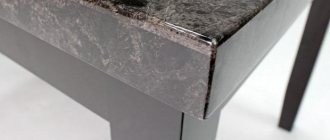This video lesson from the OchumeletsTV channel is about how to cast plastic at home. Molten plastic is not completely liquid. This is a thick mass, so it is poured under pressure. To create it, the master made a metal syringe. I used a plumbing squeegee. Piston. Guide.
Solid mold. Made from epoxy resin. Make a screw lamb. Polypropylene was used as a raw material. From an old box. At home, it is better to cast polypropylene and polyethylene, since these plastics are non-toxic.
When heated, they do not emit harmful products. Fill small pieces into a syringe. We put it in the oven at 220-240 degrees. The part is simple, so the plastic should not be overheated. While the plastic is heating up we will assemble the mold.
First, secure the bolt to the required distance. Just pull by hand, no wrench needed. The pressure is not so high. To prevent the bolts from moving back and forth, we use a cap. Chipboard material. Install the cover and tighten it with nuts. We will pour plastic into the hole.
30 minutes have passed. We put on special gloves and take out the syringe. Let's quickly wind it up. Apply pressure to squeeze out the plastic. Installed on top of the mold. Let's press. We wait a certain time. It must be kept under pressure to minimize shrinkage. Let's analyze the form and see what the product turned out to be.
It's obvious that everything has spilled. Let's extract it. The detail worked. The bolt is well filled and sits firmly. The protrusions can be trimmed. This way you can do polypropylene casting, etc. at home. This is the most primitive artisanal method. So that the product can be cast quickly and easily.
Manufacturing and household
Plastic recycling has long been part of the technological cycle of specialized and specialized enterprises.
Most often, production waste is recycled on site.
Enterprises can send plastic waste for recycling to specialized points and companies in an organized manner.
The great importance of recycling such materials for the environment is confirmed by various government support programs in many countries.
Enthusiasts and crafters around the world are also looking for opportunities to recycle themselves at home. This interest is due to one single factor - the total distribution of free and high-quality raw materials:
- plastic products and their fragments;
- packaging and transport containers;
- plastic dishes and bottles.
Amateur recycling is hampered by the characteristics of plastics and products made from them.
Here are the main problems of independent processing of materials from this group:
- Lack of equipment suitable for home use.
- Toxicity of plastics during processing.
- Difficulties in collecting and preparing raw materials.
The home craftsman must receive one of two results - raw materials suitable for sale, or products made from recycled plastic.
Despite these difficulties, many who want to process secondary raw materials from polymer materials have positive experiences . The results of such work are the receipt of real income for the family budget.
Deciding on the casting material
To be honest, there are even more molding materials than there are silicone varieties. Among them there is liquid plastic, and ordinary gypsum mixed with PVA glue, and even polyester resin. Substances for cold welding, low-melting metals, and so on are somewhat less popular. But in our case we will be based on some other characteristics of casting substances:
Regarding the first point, it indicates the time during which we can manipulate the material that has not yet hardened. Of course, if the production of plastic products takes place in a factory, then two minutes will be more than enough. Well, we, who do this at home, need at least five minutes. And if it so happens that you could not get suitable materials, then they can be replaced with simple epoxy resin. Where to look for it? In car dealerships or in stores for fans of aircraft modeling. In addition, such resin is often found in ordinary hardware stores.
Preparation of raw materials for disposal
How to recycle plastic? The technology is simple:
- accumulate an array of source material;
- grind a homogeneous mass of sorted raw materials;
- By heating and fusion, a semi-finished product - granules - is obtained that is suitable for reprocessing, or new products and objects are immediately manufactured.
One of the pressing problems of plastic processing at home is the grinding of raw materials. The fact is that most existing equipment of this kind is not manufactured in large series.
Common models of grinding equipment:
- Designed for large volumes of processing.
- They have too much power and performance for home use.
- Too expensive and large in size.
That's why DIY plastic recycling enthusiasts are forced to make such equipment with their own hands. Novice amateurs sometimes grind plastic manually, using improvised means and simple homemade equipment.
Melting plastic at home
Not long ago I became interested in the topic of recycling plastic waste.
.
There are already several articles on my channel about how you can melt down unnecessary plastic waste into something useful for yourself. And today, on the eve of the New Year holidays
, I decided to try to make a Christmas tree toy.
For this homemade product I used low pressure polyethylene
or
HDPE
(with the number
2
in the triangle). Various items are made from this plastic, for example, bottles for various household chemicals, as well as almost all drink caps.
As a casting mold, I decided to take the bottom of an aluminum can
. It is ideal for this kind of crafts. My particular bottom had one drawback. There were numbers written on it with some kind of ink, which slightly spoiled my craft, leaving fingerprints on it.
If you have the opportunity, use bottoms without inscriptions.
In this bottom I pour pre-shredded white plastic, which a couple of days ago were shampoo bottles
and
whiteness
. You need to pour enough of it to hide the bottom. At first I filled the plastic to the brim, but then I realized that I had gone too far.
Next, we heat our plastic on a gas stove
until it softens.
Surely, you can use other heating methods, such as a hair dryer and an electric stove, the main thing is to achieve the required temperature, about 175 degrees Celsius.
Then, this softened plastic must be compacted
, to obtain a mass with a uniform layer.
We must try to fill all the voids with plastic and squeeze out all the air that remains between the molten particles. hex bolt
for this . It is necessary to repeat the heating and compaction procedure several times to obtain sufficient surface quality.
After thorough compaction, it is necessary to allow the plastic to cool.
.
Plastic retains heat very well and therefore takes a long time to cool down. To speed up this process, I placed my workpiece under running cold water
. Thus, in a matter of seconds I achieved almost complete cooling of the plastic.
Using a knife
, I separated the plastic blank from the aluminum bottom. As you can see, all the inscriptions that were on the can were imprinted on our part. They were partially wiped off with a steel wool for washing dishes, but it would be better, of course, to find a bottom without inscriptions.
Manual grinding
An enthusiastic craftsman can chop small volumes of extracted raw materials manually using ordinary scissors.
To practically implement this method, you can use two pairs of scissors - with long blades for easy cutting of the side walls of plastic dishes and with short blades for labor-intensive work with the necks of bottles and the bottom.
The material of PET bottles is perfectly cut with this tool.
Scissors allow you to manually perform the entire cycle of operations for preparing and crushing raw materials:
- Remove the protective ring of the cap from the neck of the bottle
- Cut the bottle into small pieces
- Grind the hard neck and bottom in a separate operation.
The craftsman may decide not to process the complex parts of the bottles, collecting them separately for special processing. Such processing takes a lot of time and its effectiveness is low.
Applications of polymer injection molding
Using technology that involves plastic injection molding, it is possible to produce simple and complex plastic parts. There are no restrictions on the dimensions and number of products. This method is used in the automotive industry, electronics, chemical and many other industries. Using the plastic injection method, it is possible to quickly and with the required level of quality produce:
- different packaging, lids and different caps;
- a wide range of children's toys;
- housings and components for electronic equipment;
- components for medical equipment and other products.
The simplest equipment for cutting bottles
Ideas for a simple homemade device for cutting a bottle into an endless strip are widespread on the Internet. This technology is inferior to cutting into small pieces, but a thin narrow strip is suitable for heating in a compressed state .
There are also more complex devices that allow you to cut a bottle at high speed.
Further improvement of this equipment leads to the use of an electric drive for winding the tape and rotating the bottle.
On a limited scale, PET bottles can be crushed using suitable kitchen equipment, for example, using a juicer.
Use of suitable equipment for purposes other than those intended:
- ineffective due to accelerated wear of the cutting element - the toothed disc;
- dangerously unpredictable operating mode of the electric machine;
- creates difficulties by shredding the plastic too much.
Experimentation with such adapted equipment is valuable in accelerating the accumulation of experience in the field of recycling and the possibility of refining cutting technology.
You may find information about industrial crushers for plastic waste useful.
Main types of defects and methods for eliminating them
During the injection molding process, due to violations of the technological process, excess melt temperature and other factors, defects occur that reduce the quality of the product:
- Incomplete filling of the mold (underfilling). Occurs due to insufficient volume of injected polymer. This situation is possible due to weak heating of the melt, low fluidity of the mass, clogging of the nozzle or distribution channels.
- Exceeding the volume of the mold (overflow) during the plastic molding process, causing the formation of burrs at the joint (burst). The defect occurs due to a malfunction of the dispenser or exceeding the permissible temperature of the molten polymer. The release of excess mass also occurs when the mold is not closed tightly enough.
- Joint seams are visible at the boundary of the soldering of individual parts of the part, which are characterized by low strength. Such joints are formed when the plasticization temperature is too low. The cause of the defect also lies in improper design or insufficient heating of the injection mold, which leads to premature cooling of the streams before they merge. As a result, complete welding cannot be achieved.
- Bubbles form on the surface of the product, and there are voids inside. Such a defect is the result of the presence of volatile components in the melt, characterized by increased gas release when overheated. The soft mass swells.
- Formation of shrinkage cavities (depressions) on the surface. The cause of the defect is increased shrinkage of the mass in case of overheating or insufficient volume of molten mass due to low pressure, as well as insufficient throughput of the nozzle. Such sinkholes appear when the injection mold is heated unevenly and has insufficient ventilation.
- Warping of manufactured parts. Defects occur when excessive internal tension occurs due to temperature unevenness of parts of the mold. Poor-quality products are also obtained if the time required to hold the mass for complete hardening is not observed.
- Cracks on the surface. They occur due to residual stress or in case of strong adhesion of the liquid mass to the walls.
- Surface defects of parts, manifested by scratches and chips. Defects occur in the event of careless handling of finished products or poorly designed molds.
- Patterns that resemble frosty patterns on glass appear due to excessive amounts of moisture in the injected molten mass. A deficiency occurs when the drying and ventilation process of the mold is disrupted.
- If there is moisture in the polymer material in excess of the established norm, delamination of the structure occurs. The defect also occurs when there are frozen sprues that are not aligned with the main mass.
- Uneven (different) tone color of the product. The reason is the use of a thermally unstable dye and overheating of the molten mass.
- The received product does not meet the required dimensions, exceeding the standard tolerance. It occurs due to severe shrinkage of the plastic during hardening or a poorly made mold.
DIY plastic shredder
The only rational option for an individual craftsman to obtain a machine for shredding plastic bottles is to make it himself or order it from a specialized workshop .
There are few designs of such devices, but they all require the use of:
- Design competence in the field of mechanics.
- Metalworking technologies.
- Skills in assembling, setting up and operating machines and mechanisms.
Equipment of this kind uses two grinding principles. One is based on a cutting process that involves two sets of blades, reminiscent of the operation of scissors . The other is based on cutting technology, where the material is crushed by tearing it with saw teeth.
Often it is the cutting technology with a gear cutting unit that is most suitable for the home craftsman.
Here are its main advantages:
- low electric drive power – starting from 0.3 kW;
- ease of drive transmission or its absence when the cutting element is mounted on the motor shaft;
- availability of all parts in finished form and the possibility of using factory structures and components.
Such equipment has disadvantages that are typical for models of all types:
- Cutting equipment hazard.
- The need to catch dust and small trimmings.
- Noise at work.
The technology for making a home chopper yourself is simple.
The main element of such a device is a set of circular saw blades, mounted on one axis closely or through spacer washers.
A bottle is fed onto the rotating set, which instantly turns into a handful of sawdust.
This model can be made in a more complex version with rotating knives that cut together with fixed blades.
for the master to develop the design of his device independently , this will allow him to:
- use ready-made components and parts from other equipment, for example, from a washing machine;
- provide the required level of hand protection;
- think over the adjustment and configuration system;
- provide favorable performance and power handling.
Such a device, which is often called a shredder, will provide very effective preparation of raw materials. Proper design and quality workmanship will ensure long-lasting performance and efficiency.
You will find even more information on making plastic shredders with your own hands here.
A little about casting technology at home
5 plastic products in two hours
To make plastic products, some preparation will be required - you need to make a silicone matrix, as well as a tabletop substrate from the same material.
Casting molds are made from high-quality Elastolux silicone. Master models made on a 3D printer or original industrial production models are taken as the source material.
Substrates are usually made from cheaper silicone materials, for example, Elastoform.
Agglomeration and granulation
The crushed raw materials can be further processed.
At home, you can perform agglomeration and granulation.
Agglomeration is the sintering of an array of crushed plastic into small volumes (by agreement with the consumer).
Granulation is the complete melting of crushed material and the formation of granules of the same fraction from it.
The features of the material obtained in granules also need to be agreed with the buyer of such a product.
Depending on the final goal, the master equips his area with the necessary equipment. In practice, granulation is in demand much more often than agglomeration.
Preparation of material for casting
At home you can create lids, toys, souvenirs, household utensils and other solid objects. For the procedure you need to prepare a number of materials:
- plastic for casting;
- melting container;
- master model;
- mold;
- lubricant
And other means.
For casting, plastic scrap can be used, which is crushed and melted. However, the melting point of all types of plastics differs, and only one specific type is used to create the blank. If this rule is not followed, the plastic melts unevenly and the parts created from it turn out to be inhomogeneous and bubbly.
At home, it is easier to use ready-made mixtures, such as liquid plastic or epoxy resin. The material does not require melting, it cooks and sets quickly, and products made from it are not inferior in quality to analogues. As an alternative, AKP-7 powder is also suitable, requiring mixing with a solvent. It takes longer to prepare plastic from it, but the result is pleasing.
However, if you still decide to melt scrap, for example, old boxes, buckets, dishes, you should follow safety precautions and carry out casting in ventilated, non-residential areas, since plastic fumes are toxic and dangerous to humans.
Self-production of a granulator
To manufacture granulators, you need to understand the features of this process. Here's what it is:
- The crushed raw materials are heated until melted and a homogeneous plastic mass is obtained.
- The melt is pressed through holes - dies, and the resulting threads are cut into granules.
- The resulting granules are cooled to prevent sticking.
To independently manufacture a granulator, it is very useful for a master to make such a device in a primitive, but quite workable version.
As equipment for processing plastic into granules, you can use a regular meat grinder, which you can turn into a granulator with your own hands.
A heated melting chamber must be attached to the receiving compartment of , to which a storage hopper is adjacent on top.
The meat grinder screw and its body must also be parts of the heated unit.
The granules coming out from under the knives must be cooled by air flow.
This primitive diagram will allow you to work out the key components of the design and understand the features of the process.
In the operation of a granulator, the ability to adjust technological operations is very important.
Many parameters need to be adjusted:
- melt temperature;
- intensity of melt supply to the cutting unit;
- cooling parameters and method (air or water);
- cutting speed of melt flows into granules.
Having gained practical experience in operating a granulator, a home craftsman can create a more productive machine . Using components and assemblies from other equipment will greatly simplify the work.
Here's what you can use:
- Heating elements or nichrome spirals.
- Metal containers for household use - buckets, drums from old washing machines.
- Elements of pneumatic and hydraulic equipment for extruding the melt.
- Temperature sensors in the range of up to 300 degrees.
A prudent master will make a granulator in such a way that the unit for cutting flows into granules will be removable, and instead of it a nozzle can be installed to obtain a solid melt flow.
Thus,
the granulator will work like an extruder .
Recently, extruder manufacturing has become the object of wide interest.
This device allows you to obtain filaments for 3D printers.
The need for DIY extruder production proves the possibility of profitable DIY processing of plastic raw materials.
Mold making
Next, watch a video on how to make a mold for pouring plastic.
Polypropylene casting machine
The author of the OumeletsTV channel showed a self-made machine for home plastic molding. It's electric. The piston is manual. Thermostat for precise temperature control. The video shows his tests. For these purposes he will cast nylon or polyamide. There is another name - nylon. Chair crosspieces are usually made from nylon. The master found just such a thing, he crushed it. Before use, the mug must be dried at a temperature of up to 100 degrees. This must be done within 2-4 hours.
Load the granules into the machine. Let's set it to 250 degrees. This is the optimal temperature for polyamide casting. Let's wait until the required degrees are reached. Then we will install the piston. The machine has reached optimal mode, the indicator light is on. Now you need to wait 5 minutes for the plastic to completely warm up from the inside.
The polyamide has warmed up. We put it on the mold. We press in. We do pressure aging. It's obvious that he's flooded. Let's let it cool a little. Now let's disassemble the mold. Studied plastic product. As you can see, there is no shrinkage.
What can you make at home?
The reuse of plastics does not allow for the production of high-quality products. However, the range of home workshop products can be large.
The technology for home-made plastic products involves filling a mold with a melt squeezed out of an extruder.
A variation of this technology is to obtain a profile corresponding to the die in the extruder nozzle. The main thing in this technology is the correspondence of the model parameters to the potential of the device .
The master needs to find a match:
- melt parameters;
- mold temperature;
- techniques for cooling and removing the product from the mold.
Molds are most often made of metal. For complex products, the most difficult thing is to ensure the correct configuration of the mold, ensuring accurate removal of the product, and first of all, complete filling with the melt.
Here are some examples of products suitable for making in a home workshop:
- small containers for use without increased loads;
- decorative items, copies of sculptures and bas-reliefs;
- interior elements - linings, plugs, inserts;
- some elements of finishing and equipment of machines and mechanisms - covers, housings, fasteners.
It is important to understand that thin and precise shapes are difficult to make at home. In amateur production, simple and even rough forms are obtained , to which great efforts will not be applied.
To manufacture and sell children's toys, it is necessary to undergo sanitary and general safety examinations required by law.
Plastic injection machine at home
Below is a video explaining how to make a plastic injection molding machine. What do you need for this in a DIY home environment? Rod with piston. Three-quarter pipe as a cylinder. Half inch adapter to 3/4 pipe. Fitting cut off for convenience. Metal gasket with mica for insulation. Thermostat. It regulates temperature up to 350 degrees. 600 watt ten. Two nuts and a box for attaching the thermostat. We put on the adapter. We tighten the washer. To prevent the nichrome from sliding down.
We begin to assemble the control unit. Then we attach the thermocouple from the thermostat to the cylinder body. The author did not show how he would assemble all this, but presented a diagram. The photo shows the device assembled.
We attach the control unit to the syringe. Tighten with nuts. The thermocouple is long enough. Now you need to secure it. Mica to prevent thermocouple from slipping through ceramic insulators. For rewinding, not just a thread is used, but a silica one. It is heat-resistant, that is, it does not burn or melt. You can use asbestos cord. But since the master did not have it in stock, he had to buy silica.
We wrap it with heating element. Next, you can use mineral wool or asbestos fabric. Necessary to avoid heat loss. The master used mineral wool from an old oven. Fixed it with aluminum wire. Assembly is complete. Pressure tests can be carried out.
Set the thermostat to 100 degrees. Let's see how the machine will work in this mode at home.
Benefits of Home Recycling
The difficulty of efficient plastic recycling is due to the low cost of these raw materials.
Low efficiency and profitability are typical even for equipped production, which is managed by many specialists. All the more problems await when recycling plastic at home.
The main difficulty of amateur plastic recycling is the large amount of time spent collecting and sorting raw materials.
Intensifying this process is one of the ways to make a profit from plastic recycling.
The home recycler must understand the basic benefits of his position in order for his work to be profitable.
Here are some
benefits of doing it yourself in plastic recycling :
- Unlimited possibilities for invention and the most rapid implementation of innovations.
- No unnecessary burden in the form of real estate payments.
- Full control over the production cycle and schedule, including seasonal ones.
That is why the restoration of plastic from recycled materials can be recommended to a craftsman with a developed imagination , a desire for search and invention.
Also read the article about the business of recycling plastic waste.
Examples of defects and solutions
High-quality plastic injection molding that meets standard requirements is ensured by using a technically sound machine, strictly following technological steps and using high-quality raw materials. The table lists the types of defects and actions to prevent them.
| Defect | Why does it appear | How to eliminate |
| On the surface of the product: | ||
| bubbles | The moisture content of the polymer is exceeded | Drying of used raw materials |
| matte spots | Superheated viscous mass | Reduced melt heating. Polishing injection channels |
| dark stripes | Local overheating of the melt. Free zones in the intake ducts | Reducing the plasticization temperature. Removing Dead Zones |
| film | Used a lot of lubricant for the injection molding structure | Cleaning the cylinder, mold. Minimizing lubrication |
| lines | Increased viscosity of the polymer material and uneven volume filling | Control of completeness of filling of the pressing mold |
| presence of voids | Violation of the temperature regime due to air leakage into the mold | Increasing uniform ventilation efficiency. Reducing the melt feed rate |
| Local burnout of a part | Heating of gas in the molding volume due to its compression | Ensuring form ventilation |
| Dirty product | Foreign particles or worm defects in the melt | Control of the raw materials used and the planes in contact with the viscous mass |
| Surface waviness on the side of the part opposite the sprue | Cooling of the mass during injection | Temperature adjustment |
| White spots that look like bubbles | Excessive heating, low casting pressure, short polymer exposure | Reducing channel heating, increasing pressure, adding time for polymer crystallization |
| Seams near the sprue | Cooling of the molten mass too quickly at the feed point | Heating the mold near the sprue, increasing the nozzle geometry |
| Weak welded joints | Accelerated cooling of the viscous mass at the stage of filling the volume | Heating the mold and polymer. Raising injection pressure |
| Part delamination | Ingress of third-party inclusions. Large temperature difference between viscous mass and shape | Cleaning the cylinder and channels |
| Grat at the junctions | Ineffective part mold locking | Increasing the closing force, reducing the feed rate of the viscous mass, reducing the pressure and reducing the volume of the feed mass |
| Difficulty removing products | Violation of technology, form of suboptimal design | Reducing pressure, polishing the mold mirror, forming air layers |
Injection molding technology, implemented on modern equipment in compliance with process requirements and the use of high-quality raw materials, allows us to produce large quantities of high-quality products that are in demand in various industries and domestic conditions. By choosing the optimal plasticization method, it is possible to establish cost-effective production of parts of any complexity.
Results
Ideas for cooperation are relevant in the field of plastic recycling. For an independent home handyman, it is important to cooperate with a large specialized company .
This is what such cooperation gives to an individual:
- constant contact with relevant specialists in all areas of recycling;
- clarification of market demand for plastic recycling products;
- receiving assignments and selling products.
A large enterprise also benefits from contacts with an amateur craftsman. He can be entrusted with work and operations that are unprofitable for large-scale production.
The best craftsmen can count on research orders. Such work is always important for refining old and developing new technologies . Recycling plastics requires special creativity.
What was the first artificial plastic?
The first artificial plastic was made in 1856 in Great Britain by Alexander Parkes. He made the first bioplastic and called it Parkensine. Parksin was made from cellulose nitrate. The first artificial plastic was flexible, hard and transparent. Over time, certain changes were made to Parkensine that made it celluloid. This was done by adding some camphor to the cellulose nitrate used to prepare Parkensin. Celluloid was a common component used to make billiard balls.
Speaking of synthetic plastics, Leo Baekeland from Belgium invented bakelite plastic, which is resistant to heat, electricity and chemicals. A very common non-conductor. Bakelite is very popular in the electronics field.
